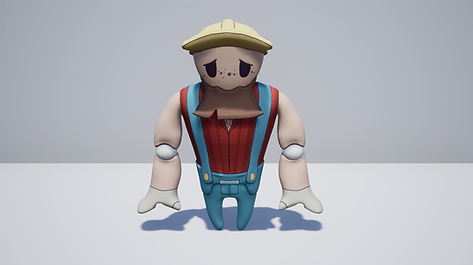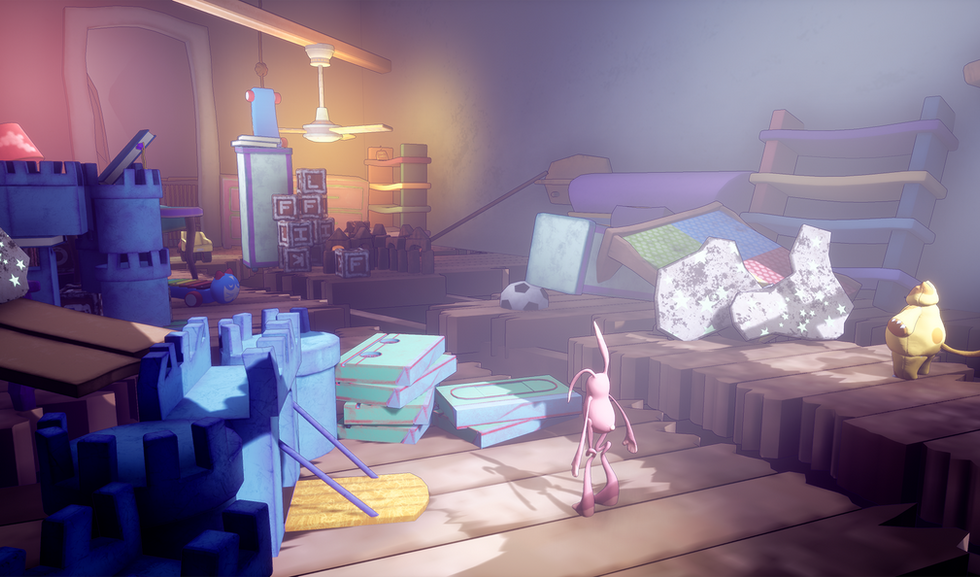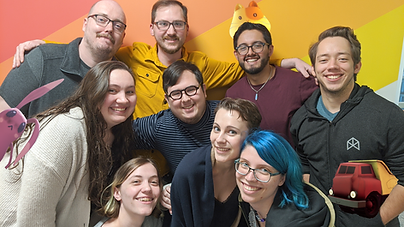Felix Faeh
Level Designer
Jumpy 'n' Stompy


Genre: 3D Adventure Platformer
Type: Couch Co-op Multiplayer
Platform: PC
Engine: Unreal Engine 4.21
Dev Span: Winter 2020 - Spring 2020
Team Size: 9 (+6 Outsourcing )
Work Methods: Agile Scrum & Perforce
My Responsibilities: Game & Level Design, Implementation, Marketing
Awards
SCAD Global Game Jam 2020: Best of Show Winner

Inspirations
Jumpy 'n' Stompy was inspired by the retro homey look and feel of 80ies/90ies Childhood, with it's memories of physical toys, still away the digital age. Toy Story formed the based of the idea. What if the players could take the role of plushies, that needed to work together as friends, like in Toy Story. The TV Show Full House was another inspiration for the overall tone and imagination of the family, that owned the toys. We wanted it to feel whymiscal with a touch of innocent with a focus on friendship. The theme 'repair' of the Game Jam 2020, was a stake for us, to work towards the idea of repairing one another, but also the hurricane, that ensued over the familie's home.


Design
Jumpy 'n' Stompy was designed around the idea of helping another, while advancing together. The challenges the player faces are puzzles in which they have to tear apart their plushy limbs and throw these to the other players, which can resew them. Once attached, the game mechanics effects associated with these limbs can be used on that character.
One example is Stompy's paws, which allows for destroying brittle objects in the way. Another example are Jumpy's legs, which allows the player to jump, since the legs have springs attached.
Since both characters are separated from each other and cannot reach each at the beginning of the game, due to a large crack in the floor, the players will have to share limbs back and forth, in order to get through the challenges.
Adhering to the Game Jam Theme "Repair"
The 2020 Theme of Game Jam was repair and from a design perspective, we felt it was very befitting that repair should be a constant action within the game. But being repaired and needing repair go hand in hand, which is why we came up with the idea of tearing the plush limbs apart and continuously reattaching them, with the added twist that you need to share your limbs with someone else.
On a large scale, this meant that you had to help repair one another in weird seeming ways, but only through teamplay, could both advance the level.
Another prevelant theme to repair is the setting of our game, a family house, that was destroyed by an earthquake and was kept in disrepair.
Much like in one of our inspirations for the game, Toy Story (Disney Pixar), we had the narrative of a young kid, who saddened had to abandon their toys. But since the toys were trying to get back to the kid, they were essentially trying to repair the childhood of their kid.
Level Design
It was important for the levels to challenge the players in a way that they are inclined to keep swapping limbs back and forth. In the first level, the players start off separated, each with their own path. At the end of the level they come together to repair the toy truck. While in the second level, both players start together and they get to decide who takes which path, which gives some replay value to the whole level.
The Level will lead them up and down on children room objects, many memorbilia and nostaligic items, we developer used to have in our own child hood. The casset tapes in particular rang nostalgia, since they have fallen out of rotation entirely today.
A large gorge separates the two toys and although they have their own path, they need to combine each other's parts to move forward, leaving them to communicate with the other player, once they hit a dead end.
Level Blockout


hover over image to display the early stage level blockout
Character Design
Jumpy and Stompy were designed as contrasting figure. Stompy being a generously proportioned cat, while Jumpy and lanky tall bunny. It followed the notion of thick and thin, embodied in our main characters. Initially, we designed jumpy to be much smaller, but had to use the same height on both characters, since the they should be able to share different limbs, but on the same rig, which is why we had to create one rig for both characters.
Then there is Tonka Truck and the Mechanic, as the supporting characters of the game. They will help Jumpy and Stompy in the levels to come, each bringing their own unique strength to help the toys get back to their owner. The mechanic in particular will pass the duo his own limbs, allowing them to use a third ability, while the track can push open gates for the toys to go through.











